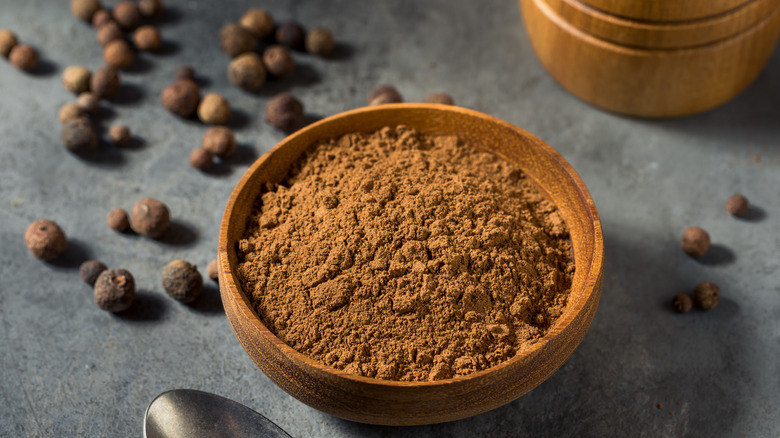Despite What You May Think, Allspice Is Not A Spice Blend
Chances are you've seen allspice listed on a recipe for pumpkin pie or gingerbread cookies before and wondered: What is this spice blend, and what can I do if I don't have it on hand? Contrary to popular belief, however, allspice is not a spice blend. It is a single spice made from berries of the pimenta dioica, a type of evergreen tree originating in the West Indies and Central America.
To make the spice, berries are picked before they ripen and then set out in the sun to dry. During this drying process, the berries shrivel up and turn from their natural shade of green to brown. The dried berries ultimately look like little peppercorns and are sold in spice jars around the world in whole berry or ground form.
Allspice sometimes gets confused as a blend, but the all-encompassing spice name was given due to the fact that the dried berry tastes like a combination of other warm spices, most notably cinnamon, cloves, nutmeg, and black pepper. Also known by other names such as Jamaican pepper, allspice is a key ingredient in Jamaican jerk seasoning. Additionally, allspice has a slightly smoky, warm, and powerful peppery flavor that works well in recipes with a nice balance of sweet and savory taste components.
How to use allspice in recipes
Ground allspice will have more intense flavor compared to the whole berry, and is best for incorporating into baking recipes like zesty ginger snap cookies or apple muffins. A hint of allspice also works well in fruity pies to mellow out sweet, jammy notes. For savory applications, forget the pre-packaged jerk spice blends. Make your own seasoning by combining allspice with brown sugar, thyme, ginger, and other warm spices to make a flavorful rub for chicken or homemade jerk pork belly.
Allspice can also enhance the succulent nature of dishes like roasted lamb. In traditional Greek recipes, allspice is incorporated into tomato sauces alongside cumin. Toss a dash of allspice into classics like baklava, or sprinkle the spice atop pumpkin pie to add a depth of warm flavor.
The whole berry form of the spice is ideal for infusing flavor into dishes and drinks that will have time to simmer, marinate, or stew. Add whole allspice berries into brines and pickles to impart a warm, peppery flavor that will pair perfectly to balance out savory, salty notes. In stews and soups, the whole spice acts similarly to a bay leaf to meld flavors and add aromatics to the dish. You can also add allspice berries into warm beverages and cocktails, such as mulled wine or a classic hot toddy.
Substitutions for allspice
Allspice is a key ingredient to keep in your spice cabinet to elevate and add depth to a variety of both sweet and savory dishes. However, if you don't have allspice on hand, in a pinch (pun intended) you can substitute allspice with a combination of cinnamon, cloves, and nutmeg. To substitute one teaspoon of allspice, add ½ teaspoon cinnamon, ¼ teaspoon nutmeg, and ¼ teaspoon clove to a small bowl and whisk to combine. Similarly, warm spice blends can also be used in place of allspice. For example, you can use a teaspoon or two of Chinese five-spice, which contains cinnamon, cloves, and nutmeg, plus other warm spices, as 1:1 replacement for allspice.
Alternatively, you can swap out cinnamon in your recipe with allspice. Since allspice has a more concentrated flavor, you'll only need about a quarter to a third of the cinnamon called for in your recipe. If you only have the whole berries, but would prefer to use ground allspice for baking or mixing into sauces, you can grind your own in a spice grinder. Do note that the flavor of fresh ground allspice will be more intense compared to pre-ground versions.


